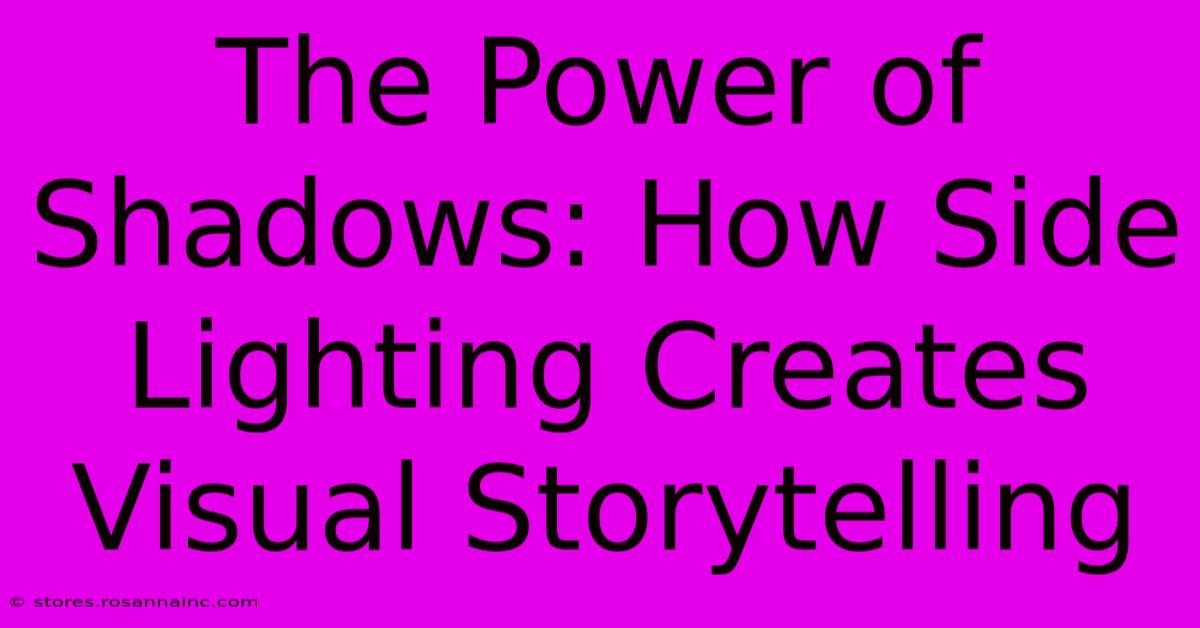The Power Of Shadows: How Side Lighting Creates Visual Storytelling

Table of Contents
The Power of Shadows: How Side Lighting Creates Visual Storytelling
Light and shadow are the fundamental building blocks of visual storytelling in photography, filmmaking, and even painting. While front lighting provides even illumination, it often lacks depth and drama. This is where side lighting, also known as Rembrandt lighting, steps in, wielding the power of shadows to create compelling narratives and evoke specific emotions. This article explores the techniques and artistic applications of side lighting, revealing how it can transform your visuals.
Understanding the Role of Side Lighting
Side lighting, as the name suggests, involves positioning your light source to one side of your subject. This creates a dramatic interplay of light and shadow, revealing texture, form, and depth in a way that frontal lighting simply can't achieve. The resulting chiaroscuro – the strong contrast between light and dark – adds a captivating visual dimension.
Key Advantages of Using Side Lighting:
- Depth and Dimension: Shadows create a three-dimensional effect, making your subject appear more realistic and engaging. Flat lighting, on the other hand, can make subjects look two-dimensional and lifeless.
- Mood and Atmosphere: Side lighting can significantly impact the mood of your image. Hard shadows can create a sense of suspense or mystery, while softer shadows can convey a more romantic or melancholic feeling.
- Highlighting Texture and Detail: The interplay of light and shadow accentuates surface textures, bringing out details that might be missed with even lighting. Think of the wrinkles on a weathered face or the grain of wood.
- Creating a Sense of Drama: The contrast between light and dark naturally draws the viewer's eye, creating a focal point and building dramatic tension.
Mastering Side Lighting Techniques
The effectiveness of side lighting depends largely on your skill in controlling the light source and its intensity. Here are some key techniques to master:
1. Light Source Placement:
Experiment with the angle of your light source. A light positioned at a 45-degree angle is often considered ideal for Rembrandt lighting, creating a distinct triangle of light on the shadowed side of the face. Moving the light closer or further will alter the intensity of the shadows.
2. Modifying the Light:
Using diffusers, reflectors, or softboxes can soften harsh shadows and create a more subtle effect. Conversely, using a bare bulb or a hard light source will produce dramatic, high-contrast shadows.
3. Background Considerations:
The background plays a crucial role in side lighting. A dark background will make the shadows more prominent, while a lighter background can help balance the contrast. Consider using a backdrop that complements your subject and enhances the overall mood.
4. Subject Placement and Pose:
The subject's pose significantly affects how the light interacts with their form. Experiment with different poses to find the most flattering and dramatic results.
Practical Applications of Side Lighting
Side lighting's versatility allows its use across diverse artistic mediums:
In Photography:
Portrait photography is a prime example where side lighting excels. It can highlight the subject's features, adding depth and character to their likeness. Product photography also benefits from side lighting, showcasing the texture and form of the products.
In Filmmaking:
Side lighting is used extensively in cinematography to create mood, atmosphere, and highlight specific characters or objects. Think of classic film noir, where side lighting helped to establish a dark and mysterious tone.
In Painting:
Masters like Rembrandt van Rijn famously employed chiaroscuro, demonstrating the power of side lighting to create dramatic and emotive scenes. Observing their work offers valuable insights into applying this technique.
Conclusion: Unleashing the Narrative Power of Shadows
Side lighting is more than just a technical lighting technique; it's a powerful tool for visual storytelling. By understanding its principles and mastering its application, you can elevate your work, adding depth, drama, and emotional resonance to your images and films. So, experiment, explore, and discover the transformative power of shadows in your creative endeavors. Remember to always consider your subject, the desired mood, and the overall narrative you're aiming to create. The art lies in the subtle balance of light and shadow, crafting a compelling visual story that captivates your audience.

Thank you for visiting our website wich cover about The Power Of Shadows: How Side Lighting Creates Visual Storytelling. We hope the information provided has been useful to you. Feel free to contact us if you have any questions or need further assistance. See you next time and dont miss to bookmark.
Featured Posts
-
The Ultimate Christmas Treat Send Out Eye Catching Dog Christmas Cards
Feb 05, 2025
-
The Most Insane Player Stats From The Timberwolves Vs Pistons Match
Feb 05, 2025
-
Uncover The Vibrant Secret What Astonishing Hue Do Green And Yellow Dance Into
Feb 05, 2025
-
Unleash The Celtic Enigma The Power Behind Knotted Patterns
Feb 05, 2025
-
Pearls And Stones Monica Vinader Rings For A Touch Of Luxury And Loveliness
Feb 05, 2025
